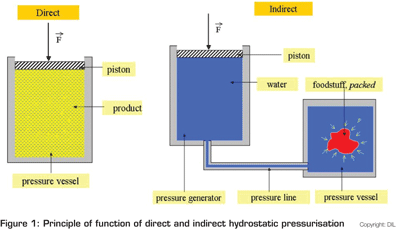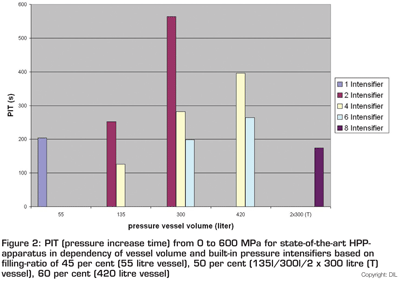Product innovation by high pressure processing
Posted: 1 June 2009 | Dr. Volker Heinz, Dr. Achim Knoch & Thomas Lickert, German Institute of Food Technologies (DIL) | No comments yet
Application of thermal heat in today’s industrial scale food production and preservation is still the most commonly used processing technique, yet thermal treatment of foods affects their physical and chemical properties severely, which is often not intended but inevitable in order for sufficient preservation. Usually, sensorial appearance (colour, flavour, structure) and nutritional value undergo significant changes due to distinct heat sensitivity of the majority of raw materials.
Application of thermal heat in today's industrial scale food production and preservation is still the most commonly used processing technique, yet thermal treatment of foods affects their physical and chemical properties severely, which is often not intended but inevitable in order for sufficient preservation. Usually, sensorial appearance (colour, flavour, structure) and nutritional value undergo significant changes due to distinct heat sensitivity of the majority of raw materials.
Application of thermal heat in today’s industrial scale food production and preservation is still the most commonly used processing technique, yet thermal treatment of foods affects their physical and chemical properties severely, which is often not intended but inevitable in order for sufficient preservation. Usually, sensorial appearance (colour, flavour, structure) and nutritional value undergo significant changes due to distinct heat sensitivity of the majority of raw materials.
High Pressure Processing (HPP) is an emerging novel processing technology for the gentle preservation of foods and is currently taking steps out of its R&D environment into industrial scale applications.
The principle of function of hydrostatic pressure is based on ‘Le Chatelier-Braun principle’, after which changes in pressure are owed to changes in volume. Reactions, phase transitions and changes in formation which are accompanied by reduction in volume occur preferably under pressure, whereas ones accompanied by an increase in volume are inhibited. Due to the isostatic principle, all molecules and atoms are subjected to the same amount of pressure at exactly the same time, unlike thermal treatment where temperature gradients exists.
HPT (high pressure treatment) affects foods in different ways, such as inactivation of vegetative microorganisms and enzymes as well as structure forming through denaturation and/or gelling while its original nutritional value and fresh taste/flavour/colour are almost completely retained.
Effects on vegetative microorganisms are caused by cell membrane damage1. The membrane is made up of a bi-layer of phospholipids. Layer volume and cross-sectional areas per phospholipid molecule decrease under pressure impact which affects membrane permeability and leads to cell damage or death2,3. Inactivation rates depend on pressure intensity, holding time, temperature (process parameters) as well as e.g. aW-value of the food (product parameters) and other factors. Furthermore, vegetative bacteria differ severely in their response to pressure. Studies indicate that gram positive bacteria, such as Staphylococcus aureus, are more resistant to pressure than gram negative bacteria like Salmonella spp.4.
Bacterial spores are very resistant towards pressure, especially to high pressure. Different studies indicate that a ‘Multi-Step-Approach’ might be the most promising in spore inactivation by first subjecting spores to low pressure under elevated temperatures, which causes germination. Activated spores can now be inactivated by a second high pressure treatment5,3.
Proteins primarily undergo changes in structure and conformation such as denaturation, gelation and aggregation when subjected to high pressure in dependency of pH-value, temperature, ion concentration and constitution of the protein6. Enzymes as proteins are like bacterial spores, relatively resistant to pressure. Combined treatment of pressure and heat is necessary to achieve a loss in activity, however full inactivation is very difficult to reach7.
HPT of lipids affects their fluidity. Conversion into crystalline state is promoted by decreased volume and leads to an increased melting point of triglycerides, which is a reversible reaction8.
Starch in aqueous suspensions/systems undergoes gelatinisation when subjected to high pressure9,10. Changes in pasting and swelling behaviour depend particularly on starch type, the amount of free water in system, pressure intensity, holding time and temperature.
The effects of HPT on food’s are comprehensive, however it has to be mentioned that many interactions are still unknown or can’t be sufficiently explained yet. Therefore, the field of HPT/HPP is the subject of intensive research activities due to the tremendous potential of this unique technology.
Processing technology
State-of-the-art industrial scale HPP equipment is operating either ‘quasi-continuously’ or in batch modus. ‘Quasi-continuous’ systems, which are limited to pumpable mediums like juice, consist of several parallel pressure vessels, operated by direct compression of the food via a piston (Figure 1). The product is transferred by a low shear pump into the vessel(s) and afterwards compressed via piston for a certain amount of time. The cycle ends with decompressing the media and transference to the filling station. Filling must be carried out under proper conditions e.g. cold aseptic filling in order to avoid recontamination. PIT -Pressure increase time (time needed to build up the full pressure inside the vessel) are low. It takes an average of 10-20 seconds to build up a pressure of 600 MPa, due to direct compression by a piston.
Batch systems are usually operated in an indirect manner and used for non-pumpable foodstuffs (Figure 1). Food is treated pre-packed in its final package so recontamination afterwards is impossible. The two main components are a horizontally arranged hollow cylinder (pressure vessel) of up to 450 litres in volume and a pressure intensifier (pressure generator). Packed food products are deposited into the pressure vessel via cylindrically-shaped containers. Afterwards, the vessel is closed and completely filled with water. Pressure intensifier(s) force now additional water into the container, due to the relative ‘incompressibility’ of water, pressure inside the vessel rises (compression of water at 600 MPa, approximately 15 per cent). PIT of indirect pressurisation is longer compared to direct compression via the piston and depends on desired pressure intensity, vessel volume and the number of build-in intensifiers. However, the PIT of high capacity HPP-apparatus of more than 300 litres can be also comparably short, depending on apparatus configuration (Figure 2).


Figure 1


Figure 2
Key parameters for throughput capacity are vessel volume, treatment cycle duration (loading, PIT, pressure holding time, unloading) and filling ratio.
Fill-ratio, the most crucial factor regarding throughput capacity, is determined by package shape and the ratio between the package’s overall volume to the actual package weight.
Product design
As already mentioned earlier, HPP in current industrial applications is mostly used for gentle preservation of delicate food products to retain its original sensorial appearance and nutritional value, like guacamole. Guacamole is a sauce/dip which is very popular among Latin Americans, made of fresh avocados and appealing by its intensive green-yellow colour and its fresh taste, which would be lost/destroyed by thermal preservation. However, HPP technology is not limited to preservation purposes only.
Product design by HPP is another emerging field of application and the subject of intensive research activities at DIL. Pressure-induced changes in structure can be used to model food products of unique characteristics which can’t be achieved by any conventional processing method.
The principle of function of cold cooking, as we like to call it, shall be explained with the example of liver sausage, which is a spreadable meat product made of cooked meat, raw/blanched intestines (liver), salt and spices (recipe constituents may vary in dependency of its origin) and is popular among consumers in Germany and other countries. Traditional liver sausage production requires two individual thermal treatments – pre-treatment of raw meat (except liver) for myofibrillar protein-denaturation to enable product spreadability (due to the inability to form an inter-connected network during final cooking) and final cooking for preservation. Both cooking processes not only take their time, in average two x 60 minutes depending on raw meat composition and sausage calibres, valuable macro- and micronutrients are lost by cooking as well. Water/salt-soluble proteins (myogen, globulin) are partially dissolved into the cooking-broth; vitamins (A, B2, niacin, C) are partially/completely destroyed due to their heat sensibility. It has to be mentioned that broth is partially added during final chopping to compensate weight loss through cooking and to regain flavour.
Cold liver sausage production by HPP requires adaptations in processing as well as recipe formulation. Raw meat parts (except liver) are minced and mixed with pickling salt. The first pressure treatment of raw meat is analogue to thermal pre-treatment designated to denaturate myofibrillar proteins to enable product spreadability. The ground/pickled meat is packed and evacuated into poly-propylene-bags prior to the pressure treatment. Since optimum pork-fat emulsification temperature is approximately 38°C, fine-chopping under cold conditions by cutter has to be carried out very carefully in order to achieve a stable emulsion. Trials indicated that increasing raw liver amount is beneficial due to the remarkable emulsification behaviour of the pork liver proteins. The second pressure treatment is carried out after the sausage batter is filled into artificial waterproof casings in order to avoid contact between product and pressure transmission mediums. Final product characteristics can be adjusted by a variation in holding time of the second HPT. The longer pressure treatment lasts, the higher the final product viscosity, respectively, the longer the shelf life will be.
Sensorial characteristics of cold processed (HPP) liver sausage differ as well. Table 1 (opposite) provides sensorial key characteristics of cold processed liver sausage compared to a standard sausage (traditional hot processing).
A comparison of both processing methods by economical aspects reveals that HPP might also offer significant cost saving potential. In cold processing, no thermal energy is needed, processing time is significantly shortened and shelf life can be extended.
Summary
HPP in food production is an emerging technology which can be used in the gentle preservation of sensitive products by retention of fresh taste, texture and colour. Furthermore, it offers the possibility to create innovative products of unique characteristics which can’t be gained by any other state-of-the-art processing technique.
HPP is not likely to replace all traditional processing methods, but it may complement such methods or find niche applications. In addition, novel physico-chemical and sensory properties obtained from this technology offer exciting opportunities for industry, especially the application of high pressure in meat and meat product processing offers huge potential in order to create a whole new generation of value added foods of unique sensorial properties.
References
1. Morita, R. Y. 1975, Psychropilic Bacteria, Bacteriol. Rev. 39, 144-167.
2. Chong, G., Cosins, A. R. (1983), A Differential Polarized Flourometric Study of the Effects of High Hydrostatic Pressure upon the Fluidity of Cellular Membranes, Biochemistry 22, 409-415.
3. Heinz, V., Buckow, R. (2008), High Pressure Processing – a Database of Kinetic Information, Chemie Ingenieur Technik (80)8 2008
4. Patterson, M F., Quinn, M., Simson, R., Gilmour, A., 1995, Sensitivity of Vegetative Pathogens to High Hydrostatic Pressure Treatment in Phosphate-Buffered Saline and Foods, J. Food Prot. 58. 524-529.
5. Ananth, E., Heinz, V., Schulter, O., Knorr, D. (2001), Kinetic Studies on High Pressure Inactivation of Bacillus stearothermophilus Spores Suspended in Food Matrices, Innov. Food Science Emerging Technology 2, 261-272.
6. Messens, W., J. Van Camp, and A. Huyghebaert. (1997). The use of high pressure to modify the functionality of food proteins. Trends Food Sci. Technol. 8:107-112.
7. Ludikhuyze L., Van Loey A., Indrawati, Denys S. and Hendrickx M. (2002). The effect of pressure processing on food quality related enzymes: from kinetic information to process engineering. Trends in High Pressure Bioscience and Biotechnology, 517-524.
8. Cheftel, J.C. (1992) Effects of high hydrostatic pressure on food constituents: an overview.” High Pressure and Biotechnology 224: 195-209.
9. Bauer, B.A., Hartmann, M., Sommer, K., Knorr, D. (2004), Optical in situ analysis of starch granules under high pressure with a high pressure cell, Innov. Food Science Emerging Technology 5 (293-298).
10. Heinz, V., Knorr, D., Buckow, R., (2006), High pressure application for food biopolymers, Biochimica et Biophysica Acta 1764 619-631




